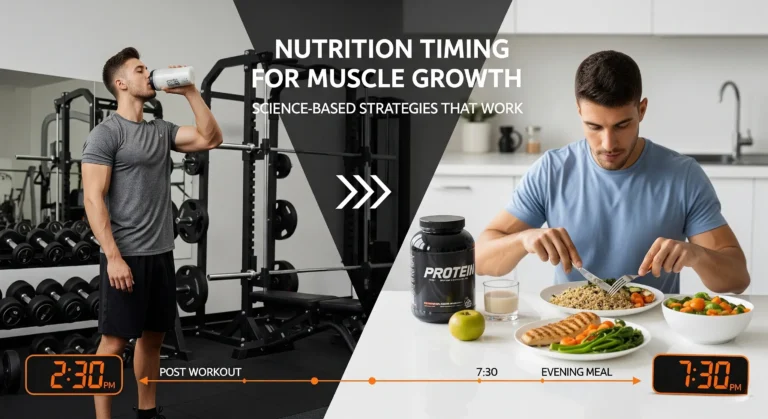
Did you know that elite powerlifters often have more muscle mass than dedicated bodybuilders? Here’s the thing – I used to think I had to choose between getting strong or getting big. That was my biggest mistake in the gym for years!
After spinning my wheels with mediocre results, I discovered that learning how to combine strength and hypertrophy isn’t just possible – it’s actually superior for most lifters. When you combine strength and hypertrophy training effectively, you unlock a level of results that single-focus programs simply can’t match. This dual approach allows you to build impressive muscle size while developing real-world strength that translates to better performance in everything you do.
I remember when I first figured out how to combine strength and hypertrophy properly. My squat jumped from 275 to 315 in just three months, and my arms grew an inch! The key was understanding that your muscles don’t care about arbitrary training categories – they respond to stimulus. The ability to combine strength and hypertrophy training opened up a whole new world of gains I never thought possible.
Understanding the Science Behind Strength vs Hypertrophy Training
Look, I’ll be honest – I used to think the science was way more complicated than it actually is. After years of reading research and experimenting on myself (and making plenty of mistakes), here’s what really matters.
Your muscle fibers are basically like employees with different job descriptions. Type 1 fibers are your marathon runners – they love higher reps and moderate weights. Type 2 fibers are your sprinters – they thrive on heavy loads and explosive movements. The beautiful thing about concurrent training is that you’re giving both fiber types exactly what they need to grow.
I learned this the hard way when I spent two years doing nothing but 8-12 reps for everything. My muscles got bigger, sure, but I felt weak as hell. Then I swung too far the other way and only did heavy triples and singles. I got stronger but looked like I barely lifted!
The breakthrough came when I realized that myofibrillar growth (the actual muscle fibers getting bigger) happens best with heavier loads, while sarcoplasmic growth (the fluid and energy stores in muscles) responds better to higher volume work. Why choose one when you can have both?
Motor unit recruitment is another game-changer most people ignore. When you lift heavy weights, your nervous system learns to fire more muscle fibers simultaneously. This creates a foundation for better growth when you do your higher-rep work later. It’s like teaching your muscles to work as a team instead of individuals.
Here’s something that blew my mind: research shows that training in the 6-8 rep range can actually produce similar hypertrophy to the traditional 8-12 range, but with significantly greater strength gains. That’s the sweet spot where both worlds collide beautifully.
Benefits of Combining Strength and Hypertrophy Training
Man, where do I even start with the benefits? When I finally got this approach dialed in, everything changed – not just in the gym, but in my daily life too.
First off, the muscle growth acceleration is real. When you expose your muscles to both heavy mechanical tension and metabolic stress, you’re essentially hitting the hypertrophy jackpot. I’ve seen guys add 20 pounds of muscle in their first year using this approach, compared to maybe 10-12 pounds with traditional bodybuilding splits.
But here’s what really sold me – the functional strength gains. I’m talking about actually being able to help friends move furniture without throwing out my back, or carrying groceries up three flights of stairs without getting winded. Traditional hypertrophy training made me look strong, but concurrent training made me actually BE strong.
The motivation factor is huge too. Let’s face it – doing the same 3 sets of 10 reps gets boring fast. When you’re mixing heavy singles with higher-rep pump work, every workout feels different and challenging. I used to dread going to the gym, but now I actually look forward to seeing what my body can do.
Recovery is another unexpected benefit. I know it sounds counterintuitive since you’re doing more work, but the variety actually helps prevent overuse injuries. Instead of constantly hammering the same movement patterns and rep ranges, you’re giving different energy systems and muscle recruitment patterns a chance to recover while others work.
Plus, there’s something incredibly satisfying about setting both strength and physique goals simultaneously. Instead of choosing between hitting that 400-pound deadlift or building impressive shoulders, you can pursue both. Talk about having your cake and eating it too!
The Optimal Rep Ranges and Loading Schemes
This is where most people mess up, and I definitely did too when I started. I thought I needed to alternate between powerlifting programs and bodybuilding routines. Wrong! The magic happens when you blend them intelligently within the same training cycle.
Here’s my go-to approach that took me years to perfect: I start each workout with my heavy strength work in the 1-5 rep range, then transition to moderate loads in the 6-8 range, and finish with higher-volume work in the 8-15 range. It’s like a pyramid that covers all your bases.
For the heavy work, I focus on the big compound movements – squat, bench, deadlift, overhead press. These are where you build your foundation of strength. I typically do 3-5 sets of 1-3 reps at 85-95% of my max. This teaches your nervous system to recruit maximum muscle fibers and handle serious loads.
The middle ground is where the magic really happens. Working in that 6-8 rep range with 75-85% of your max gives you the best of both worlds. You’re still moving substantial weight, but the higher rep count creates enough volume for solid muscle growth. This is where I spend most of my training time now.
The higher-rep accessory work (8-15 reps) is where you add volume and target specific muscle groups that might need extra attention. This is also where you can really focus on muscle connection and pump work. I learned that this isn’t just for show – the increased blood flow and metabolic stress actually contribute significantly to muscle growth.
Load management is crucial though. You can’t go balls-to-the-wall on everything. I use autoregulation now – if I’m feeling beat up, I might cap my heavy sets at 90% instead of pushing for a PR. Listen to your body, because it’s smarter than any program on paper.
Sample Weekly Training Split for Strength-Hypertrophy
After trying every split imaginable, I’ve found that upper/lower splits work best for most people combining strength and hypertrophy goals. Here’s the exact template that transformed my physique and strength levels.
Upper Body Day 1:
- Bench Press: 4 sets x 3-5 reps (strength focus)
- Barbell Rows: 4 sets x 6-8 reps
- Overhead Press: 3 sets x 8-10 reps
- Pull-ups: 3 sets x max reps
- Dips: 3 sets x 10-12 reps
- Barbell Curls: 3 sets x 12-15 reps
Lower Body Day 1:
- Squat: 5 sets x 3-5 reps (strength focus)
- Romanian Deadlift: 4 sets x 6-8 reps
- Bulgarian Split Squats: 3 sets x 10-12 reps each leg
- Walking Lunges: 3 sets x 15 steps each leg
- Calf Raises: 4 sets x 15-20 reps
Then I repeat this pattern with slight variations for the second upper and lower days. The key is designating one main lift per session as your “strength movement” where you focus on heavy loads, then supporting it with moderate and higher-rep work.
For intermediate lifters, I love the push/pull/legs split done twice per week. This gives you more frequency on each muscle group while allowing for better recovery between sessions. The mistake I see guys make is trying to max out every single exercise – that’s a recipe for burnout.
Recovery is absolutely critical when you’re combining both training styles. I learned this lesson the hard way when I tried to PR every workout and ended up overtrained and injured. Now I plan my deload weeks just as carefully as my training weeks.
Periodization Strategies That Actually Work
Periodization sounds fancy, but it’s really just planned variation in your training. After years of random workouts, implementing proper periodization was like switching from a rusty bicycle to a sports car.
Block periodization is my favorite approach for concurrent training. Instead of trying to improve everything simultaneously (which doesn’t work), you emphasize one quality while maintaining the others. For example, I might spend 4 weeks focusing primarily on strength while doing just enough hypertrophy work to maintain my muscle mass.
Here’s how I structure my blocks: 4 weeks of strength emphasis (70% strength work, 30% hypertrophy), followed by 4 weeks of hypertrophy emphasis (30% strength work, 70% hypertrophy), then a deload week. This keeps both qualities progressing without overwhelming your recovery capacity.
Daily undulating periodization (DUP) is another approach that works incredibly well. This is where you vary your rep ranges and intensities within the same week or even the same workout. One day you might squat heavy for triples, the next day you’re doing higher-rep front squats. Your muscles never fully adapt, which means continuous progress.
The key insight that changed everything for me was understanding that you can’t peak in both strength and hypertrophy simultaneously. But you can certainly improve both over time by strategically emphasizing one while maintaining the other. It’s like a see-saw – when one goes up, the other might dip slightly, but the overall trend is upward for both.
Deload weeks aren’t optional – they’re mandatory. Every 4-6 weeks, I cut my volume by 40-50% and focus on movement quality and recovery. I used to think deloads were for weak people, but now I realize they’re what separate smart lifters from injured ones.
Exercise Selection for Maximum Results
Choosing the right exercises can make or break your concurrent training program. I wasted years doing isolation exercises when I should have been focusing on compounds that build both strength and size simultaneously.
The big three – squat, bench press, and deadlift – should form the foundation of your strength work. These movements recruit the most muscle mass and allow you to handle the heaviest loads. But here’s where most people stop, and that’s a mistake.
Adding variations of these main lifts is crucial for balanced development. I rotate between back squats, front squats, and safety bar squats throughout the year. Each variation hits the muscles slightly differently and prevents accommodation. Same with bench press – I’ll cycle between competition bench, close-grip bench, and incline bench.
For hypertrophy work, I’ve found that a mix of compounds and isolations works best. After my main strength work, I might do dumbbell presses, cable rows, and lateral raises. These exercises allow me to target specific muscle groups with higher volume while using weights that don’t completely drain my nervous system.
Exercise order is crucial too. I always do my heaviest, most neurally demanding work first when I’m fresh. Trying to hit a PR deadlift after doing 4 sets of leg extensions is just asking for trouble. Heavy compounds first, moderate compounds second, isolation work last.
One mistake I made for years was trying to turn every exercise into a strength movement. Your bicep curls don’t need to be done with maximum weight for low reps – save that approach for the exercises that actually matter for strength development.
Common Mistakes and How to Avoid Them
Let me share the biggest mistakes I’ve made so you don’t have to learn these lessons the hard way. Trust me, I’ve made them all!
The number one mistake is trying to go heavy on everything. I used to think that if some heavy lifting was good, then making every exercise heavy would be better. Wrong! This approach fried my nervous system and led to terrible workouts and eventual burnout. Now I’m strategic about where I place my heavy work.
Poor recovery is another killer. When you’re combining strength and hypertrophy training, you’re placing higher demands on your body. I learned this lesson when I tried to train 6 days a week while working 60-hour weeks and getting 5 hours of sleep. My strength plummeted and I actually lost muscle mass despite training more.
Neglecting proper warm-ups nearly ended my lifting career. When you’re handling heavy weights, your body needs to be properly prepared. I now spend 15-20 minutes warming up before every session, and it’s made a huge difference in both performance and injury prevention.
Technique breakdown under fatigue is dangerous and counterproductive. When you’re tired from your strength work and then jumping into hypertrophy training, it’s easy to let form slip. I’ve had to learn to check my ego and reduce weights when my technique starts to suffer.
Not adjusting nutrition to match training demands was a huge oversight. Your body needs more fuel when you’re doing both strength and hypertrophy work. I was spinning my wheels until I increased my protein intake to 1.2 grams per pound of body weight and made sure I was eating enough carbs to fuel my workouts.
The biggest mental mistake is expecting linear progress in both strength and muscle size. Some weeks your strength will jump while muscle growth stalls, other weeks it’ll be the opposite. That’s normal and expected – trust the process and focus on long-term trends rather than weekly fluctuations.
Conclusion
Combining strength and hypertrophy training effectively isn’t about doing more of everything – it’s about doing the right things at the right time. The strategies I’ve shared here have helped countless lifters break through plateaus and achieve results they never thought possible.
Remember, your specific approach should depend on your training experience, available time, and individual goals. Start with one of the sample programs, track your progress carefully, and don’t be afraid to adjust based on how your body responds. The beauty of this approach is that you’re never truly starting over – every workout contributes to both your strength and muscle-building goals!
The key is patience and consistency. It took me years to figure out what I’ve shared with you here, but you can start implementing these strategies immediately. Focus on the big rocks first – proper exercise selection, intelligent periodization, and adequate recovery. The details will fall into place as you gain experience.
Most importantly, remember that this is a marathon, not a sprint. The lifters who combine strength and hypertrophy training successfully are the ones who think in terms of years, not weeks. Stay consistent, trust the process, and enjoy the journey of becoming both strong and muscular. Your future self will thank you for making the smart choice to pursue both qualities instead of limiting yourself to just one!



